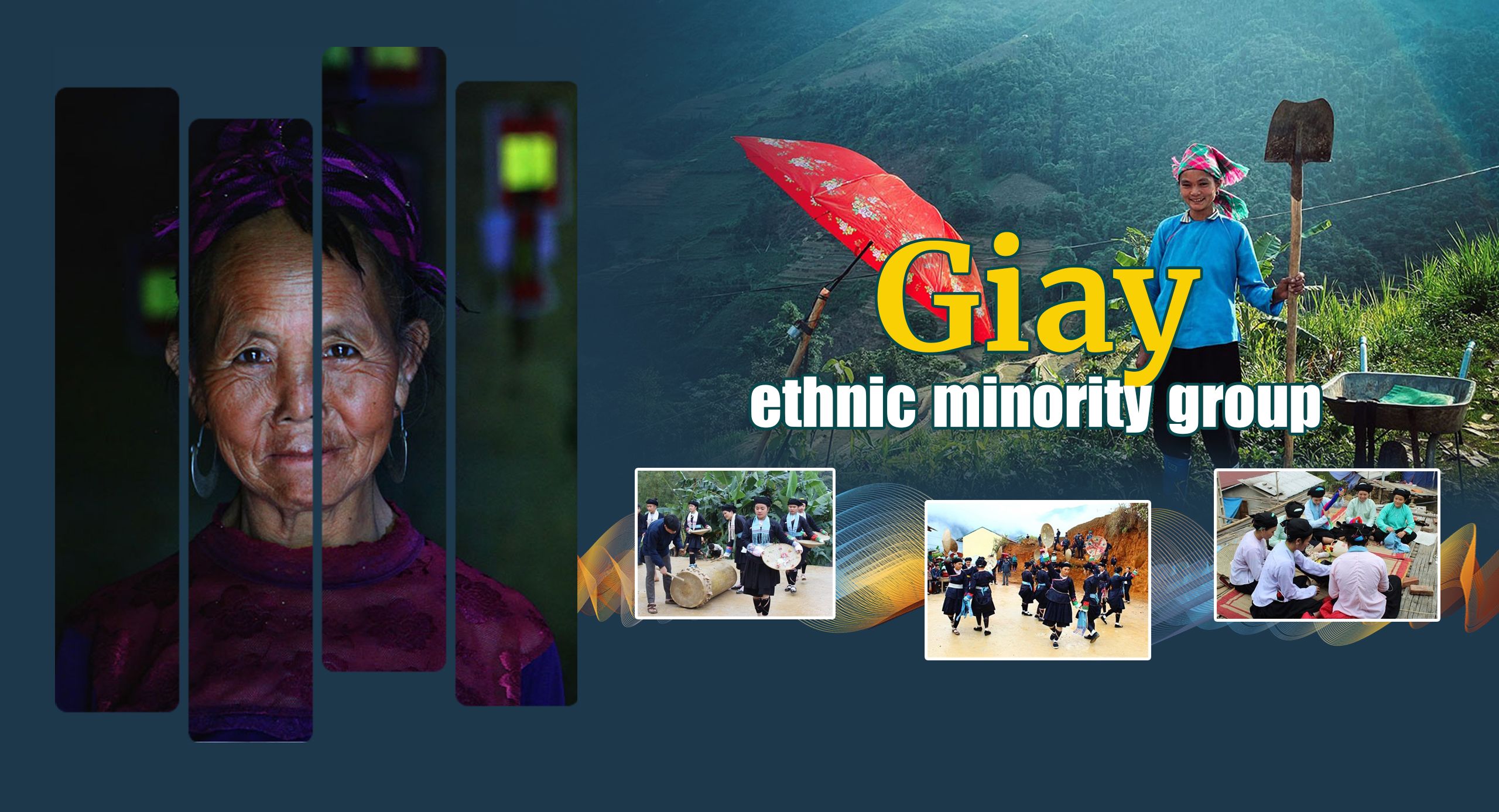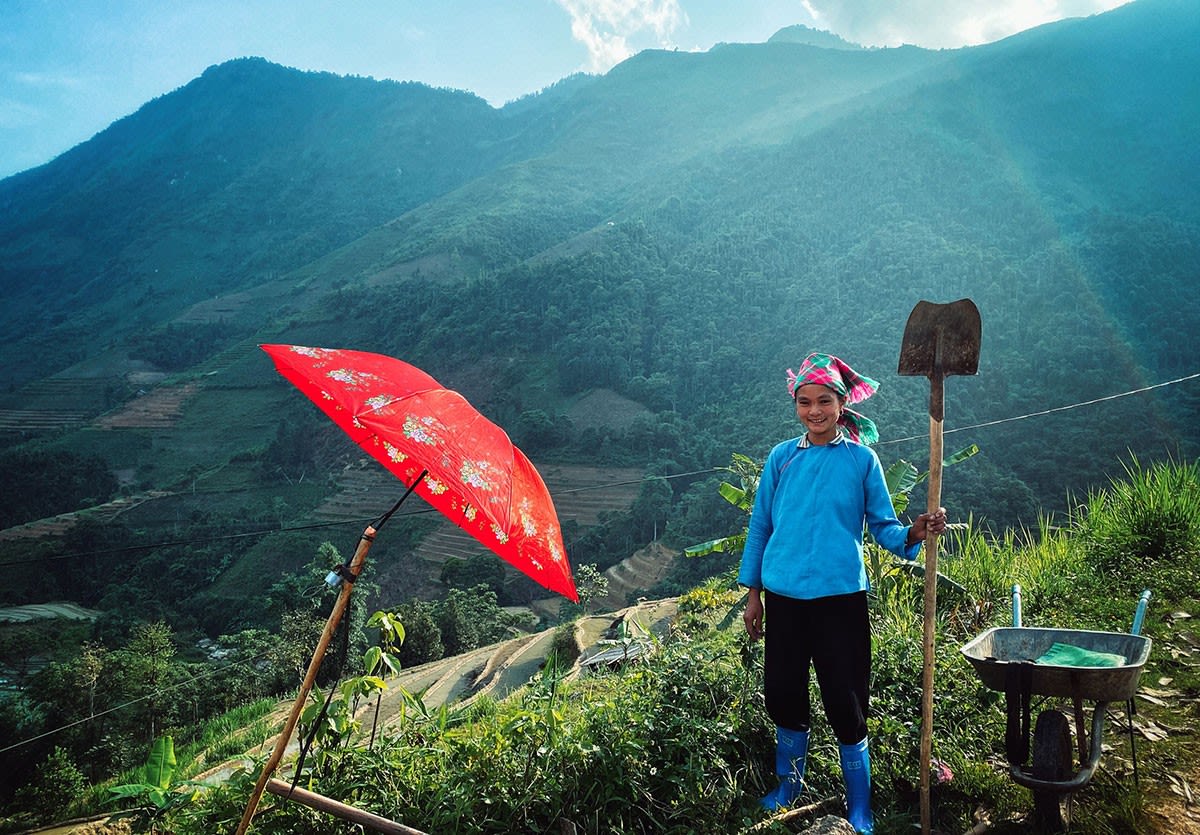
The Giay people originated from China and migrated to Vietnam about 300 years ago.
1. Origin
The Giay people originated from China, migrating to Vietnam about 300 years ago.
2. Geographical distribution
The Giay people mainly live in the provinces of Lao Cai, Ha Giang, Lai Chau and Yen Bai.
3. Population, language
Population: According to the census of 53 ethnic minorities in 2019, the Giay ethnic group has 67,858 people, including 34,624 being males and 33,234 females.
4. Language
The language belongs to the Tay - Thai language group (Tai - Kadai language family).

Daily clothes of Giay ethnic women. (Photo: TRAN THANH DAT)
Daily clothes of Giay ethnic women. (Photo: TRAN THANH DAT)
5. Main features
- Housing: Houses of the Giay people include two types: houses on stilts and houses on the ground. The Giay people in Ha Giang and Cao Bang usually live in stilt houses, while the Giay in Lao Cai live in houses on the ground. The Giay people in Trinh Tuong, Bat Xat, and Lao Cai live in ‘trinh tuong' (rammed earth houses).
The traditional roof of the Giay people is usually tiled with thatch or dry straw. The house usually has three compartments: the middle compartment is the most important and sacred place, with the main door, usually to worship ancestors and receive guests. The two sides are the bedrooms of family members, while the space behind the altar is the sleeping place for the elderly or to store things.
The traditional house of the Giay people always has an attic with an area equal to half of a compartment, which is above the fire, with stairs going up. This is the space to store agricultural products.
- Costume: The traditional costume of men is a long shirt that covers the knees and opened at the right armpit with wide sleeves. They wear loose trousers with wide legs, while often having their hair in a bun or a scarf. Recently, this traditional shirt has been modified, which is shorter than before and buttoned in the middle but not under the armpit as before.
Giay women in different localities have different traditional costumes. Giay women in Ha Giang often wear flared skirts with knee-length and long shirts that cover the buttocks, with buttons on the armpit and wide sleeves. Giay women in Lao Cai and Lai Chau do not wear skirts but black satin pants and colourful short shirts buttoned up under their armpits. Women’s pants are simply two wide legs. The head scarf is usually an indigo-dyed square scarf.
- Diet: The Giay people eat plain rice. The way to cook rice for the Giay people is different from some other ethnic groups. Firstly, they boil rice in a pan until rice is almost cooked with only a small core left uncooked, then take it out and put it in a pot to continue cooking all the rice. After taking out all the rice in the pan, the boiled water is used to drink during the day. The Giay people also make many unique cakes such as banh chung gu, banh to he, banh bong, banh khao, banh troi, banh chay, and banh ngo.
- Religion and belief: Ancestor worship is a traditional belief in the Giay community. The ancestral altar of the Giay is usually placed in the most solemn position in the middle of the house. On the altar, people often set up three joss-stick bowls with the largest bowl in the middle to worship the earth god and two joss-stick bowls on both sides to worship all the deceased in the family.
The Giay also worship the forest god and the village god. Traces of the primitive religion are still present in the spiritual life of the Giay. The form of totem worship is still seen in this ethnic group. Each family worships a different animal and the worshiping ritual also follows the features of that animal.
- Arts: The Giay people have a traditional trio of musical instruments, including drum, gong and pi le trumpet, which are often used during festivals, weddings, and funerals. The reciprocal singing style is still performed by Giay artisans in the Giay language, at weddings in Lao Cai province. The Giay have two traditional dances, the most popular being the lantern dance and the fan dance.
Regarding folklore, folk tales of the Giay people are still widely circulated in the community, often told in the form of poetry or singing. They also preserve folk verses and proverbs associated with the lives of labourers, advising people on how to work and spend money wisely.
- Economic conditions: The Giay people have a lot of experience in wet rice cultivation. In addition to cultivating food crops, the Giay people in Lao Cai also grow industrial crops, particularly cardamom and tea.
The Giay people raise livestock such as buffaloes, cows, goats, pigs and poultry. Aquatic products are also popular for the Giay. They mainly raise carp and tilapia. Besides, the Giay people also actively promote forestry occupations.
In terms of handicrafts, men often knit household items such as baskets, crates, chairs, slings and others with rattan and bamboo materials. Silver jewellery making is also one of the crafts performed by men. The sewing technique of the Giay is not complicated, they rarely use embroidery techniques on their clothes but often use coloured fabric for decoration. People also develop several side jobs such as carpentry, tofu making, cassava wine and rice wine-making.
- Education conditions: According to the 2019 survey on 53 ethnic minority groups, the rate of people aged 15 and over who can read and write is 80.1%,the net attendance rate for children of primary school age is 100.9%, and of junior secondary school age is 97.1%, and of senior secondary school age is 67.4%. The rate of children over 5 years old going to school is 99.67%.